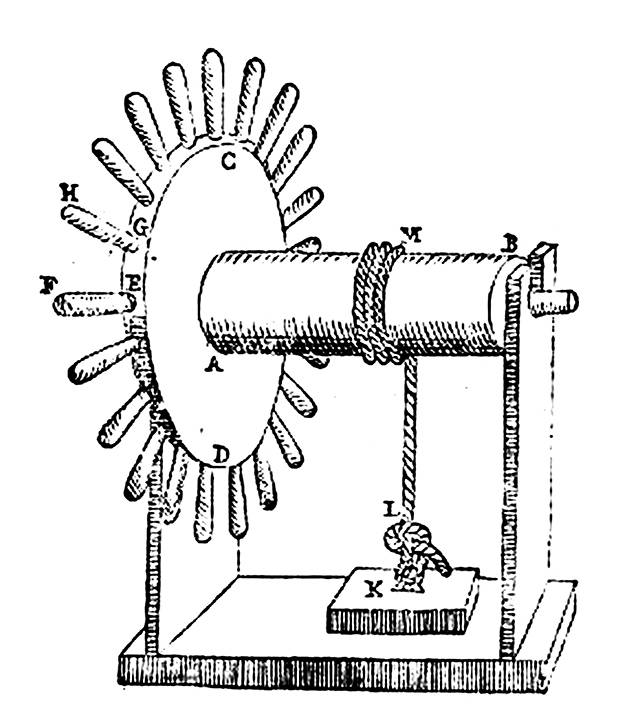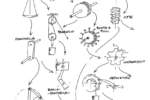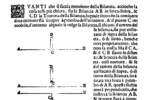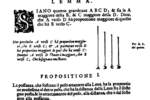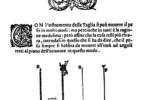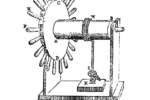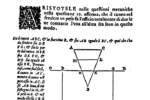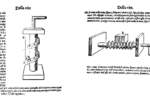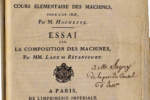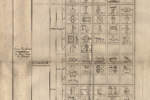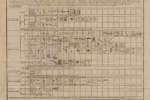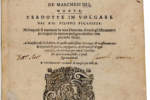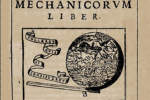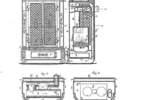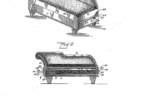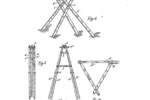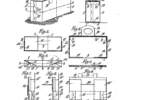“For the pillars of the earth are the Lord’s and he hath set the world upon them.” (Samuel, 2:8) The place from which Archimedes meant it would be possible to move the world has been known since antiquity, and its significance is much ampler than the mere function of the fulcrum of a lever, known to homo sapiens long before the discovery of the wheel. And also this primacy could be discussed. But so far, even if Man has become a “technological species”, nobody has yet got around to outline a complete taxonomy of mechanisms, analogously to what Carl Linné did for living species in the 18th century. His research led to the Darwinian revolution, but little has yet been done as to the evolution of the machine. We do not know much about the “simple machines” to which the ancients retraced every technological object and there is still uncertainty as to their number: are they five or six? In any case, they remained the basis of every “elementary mechanic” built according to the rules of Euclid’s Elements. By combining simple (or elementary) machines among them, it was possible to ideate and build every mechanism, and this remained the case until the 16th century when Guidobaldo del Monte, Galileo Galilei’s teacher, wrote Le Mechaniche, first in Latin (1577) and then in Italian (1581). “For the pillars of the earth are the Lord’s and he hath set the world upon them.” (Samuel, 2:8) The place from which Archimedes meant it would be possible to move the world has been known since antiquity, and its significance is much ampler than the mere function of the fulcrum of a lever, known to homo sapiens long before the discovery of the wheel. And also this primacy could be discussed. But so far, even if Man has become a “technological species”, nobody has yet got around to outline a complete taxonomy of mechanisms, analogously to what Carl Linné did for living species in the 18th century. His research led to the Darwinian revolution, but little has yet been done as to the evolution of the machine. We do not know much about the “simple machines” to which the ancients retraced every technological object and there is still uncertainty as to their number: are they five or six? In any case, they remained the basis of every “elementary mechanic” built according to the rules of Euclid’s Elements. By combining simple (or elementary) machines among them, it was possible to ideate and build every mechanism, and this remained the case until the 16th century when Guidobaldo del Monte, Galileo Galilei’s teacher, wrote Le Mechaniche, first in Latin (1577) and then in Italian (1581).The balance, the lever, the tackle, the wheel axis, the wedge, the screw: it was to these machines that Guidobaldo referred.
But in actual fact, from a certain point of view, they can all be retraced to the same principle, due to which two different forces, applied to different points of the same mechanic organ, form an equilibrium and thus make it possible to multiply the force and to change the direction in which it is oriented.
With Galileo Galilei mechanics have changed from “elementary” to “dynamic” and the forces have been tied indissolubly to the motion they provoke. Then history continues with the great scientists, and mechanics have become “classic”.
But the mechanisms have remained the same, organizing the knowledge that go from the theory of Isaac Newton’s Principia all the way to the machines of the industrial revolution, where mechanics become “applied”. In this context we cannot forget the work of the Spanish engineers and mechanics José María Lanz y Zaldívar and Augustin de Betancourt, who were the first to try to put order in a science that had been overwhelmed by progress. Their Essays on the composition of machines is fundamental for the classification of mechanisms. The Tableau des machines élémentaires forms the basis of a new mechanics that connects tradition with new prospects. This taxonomy was to lead to the grandiose plate of the Composition des mouvements: kinematics was born. This was the first chapter of a long history that, throughout the 19th century, began with Giuseppe Antonio Borgnis and continued with Robert Willis and Carlo Ignazio Giulio, finally arriving at Franz Reuleaux. The models the latter created at the Schröder Brüder House of Darmstadt were an exaltation of mechanics, attaining the very highest levels of perfection. And today, in a world where innovations only seem to exist in the pixels of a screen, we must still resort to the old but never obsolete “simple machines” and their epigones to make something move.
The theatre of things that open and close
In mechanics, the relative motion between two bodies in space may always be analysed in terms of translation along three axes and three rotations. The “Theatre” of things that open and close may be introduced by a number of objects that already in the late Nineteenth and early Twentieth centuries anticipated the paradigms of design. A stove with two hinged doors, a chaise longue that turns into a bed, a folding trestle and a cardboard box are just a few examples.
But, today more than ever, a review of things that open and close needs a taxonomy, not just for typologies of use and form, but also on the basis of their movements of opening and closing: in addition to “prismatic pairs” as the elements translating relative motion, as the tracks of a drawer are called in technical jargon, “hinges” work together in rotation, and so do the ball socket joints that limit the relative position between two elements to allow free relative rotation, in the form of rolling, pitching and yawing.
One could then begin with toys, and here the lid that opens becomes the main feature of the surprise box, while ball bearings allow the most unimaginable metamorphoses in the transformers, as for instance when a car becomes a space robot. And so in aircraft a simple hinged joint makes it possible to alter the geometry of the wings in MRCA Tornado fighter planes, while all planes that have occupy as little space as possible in aircraft carriers have wings that fold towards the fuselages. In convertible cars the hood is moved by complex articulated kinematic mechanisms that also make it possible to fold it into its storage compartment, and yachts are more and more often equipped with retractable bitts on the tacks and foldaway ladders, not just for the sake of elegance. However, this short overview on the subject of mobility would be incomplete if we were to forget folding bicycles as the Backpack-bike by Chang Ting Jen and even the ground retractable traffic barriers that are increasingly often used to delimit pedestrian areas in our old towns. Chairs, in particular, stimulate design innovation precisely because they are simple objects verging on banality and the elementary functions of seat, backrest and legs find their essential character in the rotation on a single horizontal axis, as for instance in the Plia by Giancarlo Piretti or in the Piana by David Chipperfield. The Dilly Dally coiffeuse by Poltrona Frau, on the contrary, even if it develops the theme of open versus closed both in the seat and the small table that dovetail to form a cylindrical body and in the tilting mirror, vaunts a more baroque structure. The hinged mechanisms of the Com-oda folding chair by Mr. Simon and the Cocoon Chair by Seung Yong Song make it possible to fold the elements together. The two armchairs Sosia by Emanuele Magini and Hush by Freyja Sewell apparently do without any mechanical parts, which are concealed under uninterrupted upholstery. There are also various “compact” solutions based on rotation on a hinge (Kapteinbolt, Globus) or sliding elements (Sound, Minikitchen, Celato). The same applies to Marco Ferreri’s Incanto and Luigi Caccia Dominioni’s Scaletta bar which exploit the hinge, respectively as vertical and horizontal axis, while Rek by Reiner de Jong is based on numerous dovetailing sliding layers. The application of the ouverture becomes very different when applied to lighting systems. But also in this case it is the hinge that lays down the law (Pandora Book by Philippe Starck, Pocket light by Hyun Jin Yoon and Eun Hak Lee, CuboLuce by Franco Bettonica and Mario Melocchi) and only in Hanabi by Nendo is the deformation of the flexible elements developed along a cylindrical symmetry. Another design worthy of attention is Ave Touch, the range of wall switches that disappear and reappear at the mere “touch” of a finger, and the same principle has been applied to the Adagio cooker extractor hood by Elica Design Center: small electric engines connected to a rack-and-pinion system drive the translation operation. Also the faucets Flat and 3T guarantee their disappearance with built-in dovetailing mechanisms and hinges inside sumptuous nickel-plated structures. At this point we may mention Leatherman’s Multi tools, an improved version of the archetypal small Swiss army knife, the famous Radio Cubo TS522 by Marco Zanuso and Richard Sapper as well as the Reverso watch by Jaeger LeCoultre. In all of them it is the hinge that performs the principal and simple operation of opening and closing.
If, on the contrary – to conclude – we continue to the apparel sector where flexible textiles perform the same part as the “machine” in the object, then we may arrive at Andy Wana’s. Lotus 23 umbrella where everything disappears into the handle or the short waterproof jacket Kway invented by Léon-Claude Duhamel, which can be folded into a waist-pack pocket. Also in this case elementary machines, more or less hidden inside supporting and/or decorative structures, continue to play the seductive role of ouverture.


